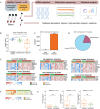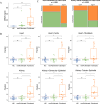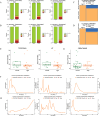cfDNA methylation detection as potential liquid biopsy of multiple organ injury in myocarditis patients
- PMID: 40537817
- PMCID: PMC12180197
- DOI: 10.1186/s13148-025-01914-z
cfDNA methylation detection as potential liquid biopsy of multiple organ injury in myocarditis patients
Abstract
Myocarditis is inflammatory injury of the myocardium and causes approximately 30,000 deaths globally each year. Fulminant myocarditis is an extremely severe form of myocarditis. Currently, the clinical evaluation of myocarditis and fulminant myocarditis is primarily based on symptoms, ECG findings, and biochemical markers. Cardiac magnetic resonance and endomyocardial biopsy can provide further support for the diagnosis, but both have limitations in routine practice. Recent studies have shown that cell-free DNA (cfDNA) has distinct methylation patterns depending on the organ of origin, suggesting new possibilities for tracking specific types of organ damage. The core mechanism of fulminant myocarditis is a cytokine storm, leading to multiorgan damage, differing from clinically suspected myocarditis. We performed Genome-wide cfDNA methylation detection on plasma from 20 healthy donors and 22 patients (fulminant myocarditis: clinically suspected myocarditis = 9:13, COVID-19 positive: COVID-19 negative = 14:8) and found that cfDNA can be used to specifically identify early multiorgan damage caused by fulminant myocarditis, and its AUC is superior to traditional biochemical indicators such as troponin, high-sensitivity troponin, and lactate dehydrogenase. This is critically important for the timely clinical recognition and treatment of this condition. Furthermore, our study findings suggest that SARS-CoV-2 infection may exacerbate the severity of myocarditis and multiorgan damage. In summary, cfDNA shows great potential as a noninvasive, early, and sensitive biomarker for reflecting disease severity and systemic injury in fulminant myocarditis, which may help guide earlier risk stratification and intervention.
Keywords: Cell-free DNA; Cytokine storm; Early identification; Fulminant myocarditis; Multiorgan damage.
© 2025. The Author(s).
Conflict of interest statement
Declarations. Competing interests: The authors declare no competing interests.
Figures




Similar articles
-
Signs and symptoms to determine if a patient presenting in primary care or hospital outpatient settings has COVID-19.Cochrane Database Syst Rev. 2022 May 20;5(5):CD013665. doi: 10.1002/14651858.CD013665.pub3. Cochrane Database Syst Rev. 2022. PMID: 35593186 Free PMC article.
-
Rapid, point-of-care antigen tests for diagnosis of SARS-CoV-2 infection.Cochrane Database Syst Rev. 2022 Jul 22;7(7):CD013705. doi: 10.1002/14651858.CD013705.pub3. Cochrane Database Syst Rev. 2022. PMID: 35866452 Free PMC article.
-
SARS-CoV-2-neutralising monoclonal antibodies for treatment of COVID-19.Cochrane Database Syst Rev. 2021 Sep 2;9(9):CD013825. doi: 10.1002/14651858.CD013825.pub2. Cochrane Database Syst Rev. 2021. PMID: 34473343 Free PMC article.
-
Antibody tests for identification of current and past infection with SARS-CoV-2.Cochrane Database Syst Rev. 2022 Nov 17;11(11):CD013652. doi: 10.1002/14651858.CD013652.pub2. Cochrane Database Syst Rev. 2022. PMID: 36394900 Free PMC article.
-
Noninvasive prognostication of hepatocellular carcinoma based on cell-free DNA methylation.PLoS One. 2025 Apr 25;20(4):e0321736. doi: 10.1371/journal.pone.0321736. eCollection 2025. PLoS One. 2025. PMID: 40279344 Free PMC article.
References
-
- Sharma AN, Stultz JR, Bellamkonda N, Amsterdam EA. Fulminant myocarditis: epidemiology, pathogenesis, diagnosis, and management. Am J Cardiol. 2019;124:1954–60. - PubMed
-
- Ediger DS, Brady WJ, Koyfman A, Long B. High risk and low prevalence diseases: myocarditis. Am J Emerg Med. 2024;78:81–8. - PubMed
MeSH terms
Substances
Grants and funding
- MTP2022A007/High throughput sequencing technology in infectious diseases
- MTP2022A007/High throughput sequencing technology in infectious diseases
- MTP2022A007/High throughput sequencing technology in infectious diseases
- 112696/Fund of infectious diseases Detection and Tumor Targeted Therapy Engineering Research Center of Henan Province
- 112696/Fund of infectious diseases Detection and Tumor Targeted Therapy Engineering Research Center of Henan Province
LinkOut - more resources
Full Text Sources
Medical
Miscellaneous

